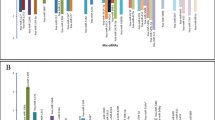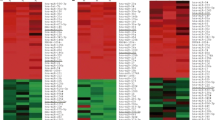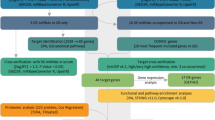Abstract
Among noncoding RNAs, microRNAs (miRNAs) have been most extensively studied, and their biology has repeatedly been proven critical for central nervous system pathological conditions. The diagnostic value of several miRNAs was appraised in pediatric dysembryoplastic neuroepithelial tumors (DNETs) using miRNA microarrays and receiving operating characteristic curves analyses. Overall, five pediatric DNETs were studied. As controls, 17 samples were used: the FirstChoice Human Brain Reference RNA and 16 samples from deceased children who underwent autopsy and were not present with any brain malignancy. The miRNA extraction was carried out using the mirVANA miRNA Isolation Kit, while the experimental approach included miRNA microarrays covering 1211 miRNAs. Quantitative real-time polymerase chain reaction was performed to validate the expression profiles of miR-1909* and miR-3138 in all samples initially screened with miRNA microarrays. Our findings indicated that miR-3138 might act as a tumor suppressor gene when down-regulated and miR-1909* as a putative oncogenic molecule when up-regulated in pediatric DNETs compared to the control cohort. Subsequently, both miRNA signatures might serve as putative diagnostic biomarkers for pediatric DNETs.



Similar content being viewed by others
References
Chassoux F, Daumas-Duport C. Dysembryoplastic neuroepithelial tumors: where are we now? Epilepsia. 2013;54(Suppl 9):129–34. doi:10.1111/epi.12457.
Ranger A, Diosy D. Seizures in children with dysembryoplastic neuroepithelial tumors of the brain–A review of surgical outcomes across several studies. Childs Nerv Syst. 2015;31(6):847–55. doi:10.1007/s00381-015-2675-9.
Spalice A, Ruggieri M, Grosso S, Verrotti A, Polizzi A, Magro G, et al. Dysembryoplastic neuroepithelial tumors: a prospective clinicopathologic and outcome study of 13 children. Pediatr Neurol. 2010;43(6):395–402. doi:10.1016/j.pediatrneurol.2010.06.017.
Ozlen F, Gunduz A, Asan Z, Tanriverdi T, Ozkara C, Yeni N, et al. Dysembryoplastic neuroepithelial tumors and gangliogliomas: clinical results of 52 patients. Acta Neurochir (Wien). 2010;152(10):1661–71. doi:10.1007/s00701-010-0696-4.
Thom M, Toma A, An S, Martinian L, Hadjivassiliou G, Ratilal B, et al. One hundred and one dysembryoplastic neuroepithelial tumors: an adult epilepsy series with immunohistochemical, molecular genetic, and clinical correlations and a review of the literature. J Neuropathol Exp Neurol. 2011;70(10):859–78. doi:10.1097/NEN.0b013e3182302475.
Qaddoumi I, Ellison DW, Morris EB, Broniscer A, Boop F, Merchant T, et al. Dysembryoplastic neuroepithelial tumors and cognitive outcome: cure at a price? Cancer. 2010;116(23):5461–9. doi:10.1002/cncr.25528.
Maschio M, Sperati F, Dinapoli L, Vidiri A, Fabi A, Pace A, et al. Weight of epilepsy in brain tumor patients. J Neurooncol. 2014;118(2):385–93. doi:10.1007/s11060-014-1449-7.
Brinkman TM, Liptak CC, Delaney BL, Chordas CA, Muriel AC, Manley PE. Suicide ideation in pediatric and adult survivors of childhood brain tumors. J Neurooncol. 2013;113(3):425–32. doi:10.1007/s11060-013-1130-6.
Tessitore A, Cicciarelli G, Mastroiaco V, Vecchio FD, Capece D, Verzella D, et al. Therapeutic use of MicroRNAs in cancer. Anti-Cancer Agents Med Chem. 2015;16(1):7–19.
Braoudaki M, Lambrou GI. MicroRNAs in pediatric central nervous system embryonal neoplasms: the known unknown. J Hematol Oncol. 2015;8(1):6. doi:10.1186/s13045-014-0101-5.
Braoudaki M, Lambrou GI, Giannikou K, Milionis V, Stefanaki K, Birks DK, et al. Microrna expression signatures predict patient progression and disease outcome in pediatric embryonal central nervous system neoplasms. J Hematol Oncol. 2014;7:96. doi:10.1186/s13045-014-0096-y.
Ferretti E, De Smaele E, Miele E, Laneve P, Po A, Pelloni M, et al. Concerted microRNA control of Hedgehog signalling in cerebellar neuronal progenitor and tumour cells. EMBO J. 2008;27(19):2616–27. doi:10.1038/emboj.2008.172.
Birks DK, Barton VN, Donson AM, Handler MH, Vibhakar R, Foreman NK. Survey of MicroRNA expression in pediatric brain tumors. Pediatr Blood Cancer. 2011;56(2):211–6. doi:10.1002/pbc.22723.
Wang F, Ren X, Zhang X. Role of microRNA-150 in solid tumors. Oncol Lett. 2015;10(1):11–6. doi:10.3892/ol.2015.3170.
Wang M, Deng X, Ying Q, Jin T, Li M, Liang C. MicroRNA-224 targets ERG2 and contributes to malignant progressions of meningioma. Biochem Biophys Res Commun. 2015;460(2):354–61. doi:10.1016/j.bbrc.2015.03.038.
Louis DN, Ohgaki H, Wiestler OD, Cavenee WK, Burger PC, Jouvet A, et al. The 2007 WHO classification of tumours of the central nervous system. Acta Neuropathol. 2007;114(2):97–109. doi:10.1007/s00401-007-0243-4.
Zhang B, Chen J, Ren Z, Chen Y, Li J, Miao X, et al. A specific miRNA signature promotes radioresistance of human cervical cancer cells. Cancer cell Int. 2013;13(1):118. doi:10.1186/1475-2867-13-118.
Della Vittoria Scarpati G, Falcetta F, Carlomagno C, Ubezio P, Marchini S, De Stefano A, et al. A specific miRNA signature correlates with complete pathological response to neoadjuvant chemoradiotherapy in locally advanced rectal cancer. Int J Radiat Oncol Biol Phys. 2012;83(4):1113–9. doi:10.1016/j.ijrobp.2011.09.030.
Ng SB, Yan J, Huang G, Selvarajan V, Tay JL, Lin B, et al. Dysregulated microRNAs affect pathways and targets of biologic relevance in nasal-type natural killer/T-cell lymphoma. Blood. 2011;118(18):4919–29. doi:10.1182/blood-2011-07-364224.
Vella S, Pomella S, Leoncini PP, Colletti M, Conti B, Marquez VE, et al. MicroRNA-101 is repressed by EZH2 and its restoration inhibits tumorigenic features in embryonal rhabdomyosarcoma. Clin Epigenet. 2015;7(1):82. doi:10.1186/s13148-015-0107-z.
Li M, Tian L, Ren H, Chen X, Wang Y, Ge J, et al. MicroRNA-101 is a potential prognostic indicator of laryngeal squamous cell carcinoma and modulates CDK8. J Transl Med. 2015;13:271. doi:10.1186/s12967-015-0626-6.
Cai J, Wu J, Zhang H, Fang L, Huang Y, Yang Y, et al. miR-186 downregulation correlates with poor survival in lung adenocarcinoma, where it interferes with cell-cycle regulation. Cancer Res. 2013;73(2):756–66. doi:10.1158/0008-5472.can-12-2651.
Cui G, Cui M, Li Y, Liang Y, Li W, Guo H, et al. MiR-186 targets ROCK1 to suppress the growth and metastasis of NSCLC cells. Tumour Biol J Int Soc Oncodev Biol Med. 2014;35(9):8933–7. doi:10.1007/s13277-014-2168-6.
Yao K, He L, Gan Y, Zeng Q, Dai Y, Tan J. MiR-186 suppresses the growth and metastasis of bladder cancer by targeting NSBP1. Diagn Pathol. 2015;10:146. doi:10.1186/s13000-015-0372-3.
Zhou P, Huang G, Zhao Y, Zhong D, Xu Z, Zeng Y, et al. MicroRNA-363-mediated downregulation of S1PR1 suppresses the proliferation of hepatocellular carcinoma cells. Cell Signal. 2014;26(6):1347–54. doi:10.1016/j.cellsig.2014.02.020.
Jamali Z, Aminabadi NA, Attaran R, Pournagiazar F, Oskouei SG, Ahmadpour F. MicroRNAs as prognostic molecular signatures in human head and neck squamous cell carcinoma: a systematic review and meta-analysis. Oral Oncol. 2015;51(4):321–31.
Qiao J, Lee S, Paul P, Theiss L, Tiao J, Qiao L, et al. miR-335 and miR-363 regulation of neuroblastoma tumorigenesis and metastasis. Surgery. 2013;154(2):226–33. doi:10.1016/j.surg.2013.04.005.
Zhang X, Liu J, Zang D, Wu S, Liu A, Zhu J, et al. Upregulation of miR-572 transcriptionally suppresses SOCS1 and p21 and contributes to human ovarian cancer progression. Oncotarget. 2015;6(17):15180–93.
Wang C, Hu J, Lu M, Gu H, Zhou X, Chen X, et al. A panel of five serum miRNAs as a potential diagnostic tool for early-stage renal cell carcinoma. Sci Rep. 2015;5:7610. doi:10.1038/srep07610.
Lu S, Wang S, Geng S, Ma S, Liang Z, Jiao B. Upregulation of microRNA-224 confers a poor prognosis in glioma patients. Clin Transl Oncol. 2013;15(7):569–74. doi:10.1007/s12094-012-0972-2.
Kunder R, Jalali R, Sridhar E, Moiyadi A, Goel N, Goel A, et al. Real-time PCR assay based on the differential expression of microRNAs and protein-coding genes for molecular classification of formalin-fixed paraffin embedded medulloblastomas. Neuro-Oncology. 2013;15(12):1644–51. doi:10.1093/neuonc/not123.
Author Contributions
MB conceived and designed the study, performed all experiments, evaluated and interpreted data analyses and drafted the manuscript. GIL performed all data analyses and participated in interpretation of data analyses. SAP performed resections of the postmortem specimens, KS performed tumor diagnosis, NP performed tumor resections and EK participated in the coordination and supervision of the study. All authors approved the final manuscript.
Author information
Authors and Affiliations
Corresponding author
Ethics declarations
Conflict of interest
The authors declare no competing financial or non-financial interests.
Ethical Approval
All procedures performed in studies involving human participants were in accordance with the ethical standards of the institutional and/or national research committee and with the 1964 Helsinki Declaration and its later amendments or comparable ethical standards.
Rights and permissions
About this article
Cite this article
Braoudaki, M., Lambrou, G.I., Papadodima, S.A. et al. MicroRNA expression profiles in pediatric dysembryoplastic neuroepithelial tumors. Med Oncol 33, 5 (2016). https://doi.org/10.1007/s12032-015-0719-3
Received:
Accepted:
Published:
DOI: https://doi.org/10.1007/s12032-015-0719-3




